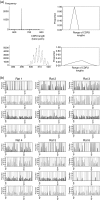Antigen receptor V-segment usage in mucosal T cells
- PMID: 17903204
- PMCID: PMC2433294
- DOI: 10.1111/j.1365-2567.2007.02685.x
Antigen receptor V-segment usage in mucosal T cells
Abstract
In the accepted model of lymphocyte intestinal homing, naïve T cells recirculate via organized lymphoid tissues, whilst induced effector/memory cells home to the intestinal mucosa. In order to assess the T-cell-receptor repertoire in the intestine and gut-associated lymphoid tissue (GALT), spectratyping was performed on the proximal and the distal intestine, spleen and mesenteric lymph node tissue from six PVG rats. The products were analysed with an automated sequencer and statistical analyses were performed with hierarchical cluster analysis. This demonstrated the presence of a restricted T-cell repertoire in the small intestine compared with that in the mesenteric lymph nodes and the spleen. It also demonstrated marked differences in repertoire between individual, fully inbred rats maintained under apparently identical conditions in the same cage and fed identical diets. In addition, this work demonstrated marked differences between repertoires in the proximal and the distal intestine. Such marked differences are likely to reflect the end result of increasing divergence over time produced by relatively subtle effects of environment and antigenic load. Equally, marked differences in repertoire between small intestinal segments within individual rats indicate selective recruitment or retention of specific clones, presumably antigen-driven.
Figures



Similar articles
-
Intestinal and splenic T cell responses to enteric Listeria monocytogenes infection: distinct repertoires of responding CD8 T lymphocytes.J Immunol. 2001 Mar 15;166(6):4065-73. doi: 10.4049/jimmunol.166.6.4065. J Immunol. 2001. PMID: 11238655
-
Generation of intestinal T cells from progenitors residing in gut cryptopatches.Science. 1998 Apr 10;280(5361):275-8. doi: 10.1126/science.280.5361.275. Science. 1998. PMID: 9535655
-
Gut-associated lymphoid tissue-primed CD4+ T cells display CCR9-dependent and -independent homing to the small intestine.Blood. 2006 May 1;107(9):3447-54. doi: 10.1182/blood-2005-07-2860. Epub 2006 Jan 3. Blood. 2006. PMID: 16391017
-
Leukocyte Trafficking to the Small Intestine and Colon.Gastroenterology. 2016 Feb;150(2):340-54. doi: 10.1053/j.gastro.2015.10.046. Epub 2015 Nov 6. Gastroenterology. 2016. PMID: 26551552 Free PMC article. Review.
-
Generation of gut-homing T cells and their localization to the small intestinal mucosa.Immunol Rev. 2007 Feb;215:226-42. doi: 10.1111/j.1600-065X.2006.00482.x. Immunol Rev. 2007. PMID: 17291292 Review.
Cited by
-
Neonatal colonisation expands a specific intestinal antigen-presenting cell subset prior to CD4 T-cell expansion, without altering T-cell repertoire.PLoS One. 2012;7(3):e33707. doi: 10.1371/journal.pone.0033707. Epub 2012 Mar 19. PLoS One. 2012. PMID: 22442714 Free PMC article.
-
Laryngeal transplantation in minipigs: early immunological outcomes.Clin Exp Immunol. 2012 Mar;167(3):556-64. doi: 10.1111/j.1365-2249.2011.04531.x. Clin Exp Immunol. 2012. PMID: 22288599 Free PMC article.
References
-
- Mora JR, Bono MR, Manjunath N, Weninger W, Cavanagh LL, Rosemblatt M, Von Andrian UH. Selective imprinting of gut-homing T cells by Peyer's patch dendritic cells. Nature. 2003;424:88–93. - PubMed
-
- Gowans JL, Knight EJ. The route of re-circulation of lymphocytes in the rat. Proc R Soc Lond B Biol Sci. 1964;159:257–82. - PubMed
-
- Abitorabi MA, Mackay CR, Jerome EH, Osorio O, Butcher EC, Erle DJ. Differential expression of homing molecules on recirculating lymphocytes from sheep gut, peripheral, and lung lymph. J Immunol. 1996;156:3111–7. - PubMed
-
- Luster AD. Chemokines regulate lymphocyte homing to the intestinal mucosa. Gastroenterology. 2001;120:291–4. - PubMed
Publication types
MeSH terms
Substances
LinkOut - more resources
Full Text Sources

